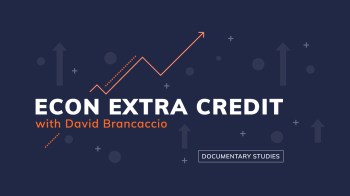
Play along with us

This month, we’re exploring what it takes to make a successful video game and how that’s changed in the past decade. Our “Econ Extra Credit” selection for May is “Indie Game: The Movie,” which is available to rent or buy on several streaming platforms.
Video games are big business. More than 3 billion people worldwide played games last year. Global revenue reached $184 billion, nearly triple sales of recorded music and the global box office combined. Analysts forecast gaming will be a $205 billion market by 2026.
While there’s a lot of money to be made, it also costs a lot of time and money to bring a new game to market. AAA games — those from large companies with the largest budgets — like Cyberpunk 2077, for example, take about $174 million and seven years to develop. Cloud Imperium Games has crowdfunded more than $600 million since 2012 to develop Star Citizen, a multiplayer space exploration game, with no official release date announced.
Players and critics often lament that as video games have become more expensive to make, companies have tended to play it safe by producing uninspired remakes and sequels rather than taking creative risks to make something original.
This month’s “Econ Extra Credit” selection, “Indie Game: The Movie,” follows four independent developers out to prove big budgets and huge teams aren’t always necessary to create compelling, successful games.
Whether a game is or isn’t an “indie” depends on whom you ask, said Shawn Pierre, a Philadelphia-based designer and chair of the Independent Games Festival, an annual event that is a bit like the Sundance festival for games. Pierre told Marketplace by email that the definition evolves every few years.
“Some people say it’s the budget, others will say that if you have a publisher, then you’re disqualified from the ‘indie’ title,” Pierre wrote. “People also consider the number of people working at the studio. The answer seems to be a mix of those factors and a few more.”
Indie games can be made for as little as $50,000. Others, like Neon White and Shroud of the Avatar, still cost several million dollars to make.
Jonathan Blow, the creator of Braid, said in the film that his goal as an independent developer was to create something that didn’t look or feel like what big game companies release, something that reflected his own identity and personality.
“Big companies create highly polished things that serve as large of an audience as possible,” Blow said early in the film. “That creation of highly glossy, commercial products is the opposite of making something that’s personal.”
The personal is possible for an indie developer like Blow because the stakes are lower. A game that sells 20,000 copies for $15 a pop would be a financial failure for a large company — the average AAA game costs $60 million to $80 million to make — but could be a huge success for an individual or a small team. But the pressure and the stress to complete the game are still high. Many of the developers in the movie lived with their parents while developing their games because they couldn’t afford their own place.
“Marketplace Morning Report” assistant producer Nic Perez first watched this documentary in eighth grade. He and his friends loved playing Super Meat Boy, an indie platformer featured in the film.
“I’m not sure what eighth-grade Nic expected from a film about his then-favorite game, but he walked away from it with a clear takeaway: Playing video games is fun. Making them is not,” Perez said.
Like the developers featured in the movie, directors Lisanne Pajot and James Swirsky approached production with a similar scrappiness. They directed, produced, shot and edited the film themselves on a crowdfunded budget.
The documentary was released in 2012, but many of the challenges highlighted in it are still plaguing the video game industry. Workers at large developers are expected to sacrifice their personal lives and health to meet unrealistic deadlines, face a constant threat of being laid off and can have their entire project shut down at a moment’s notice due to a change in funding.
And while going the indie route allows developers to have a semblance of control over their working conditions, there’s no guarantee they’ll turn a profit when their game releases — if it releases at all. Yet the documentary highlights why many developers still see value in going indie.
Play along with us
We’ll be sharing some of our staff’s favorite games all month, and we’d love to include some of yours too! What video games did you like as a kid? Do you still play them? Do you have a new favorite?
Send us your picks and stories by replying to this email or sending a message to extracredit@marketplace.org.
This week, we’ll kick things off by recommending the games featured in the documentary. These are all considered “platformer” games, requiring the player to move a character through an environment while avoiding obstacles and pitfalls.
- Super Meat Boy (2010): Meat Boy, a red, cube-shaped character, attempts to rescue his girlfriend, Bandage Girl, from the villainous Dr. Fetus. (Play Super Meat Boy on Steam.)
- Fez (2012): Gomez receives a magical fez that reveals his two-dimensional world is only one of four sides of a three-dimensional world. (Play Fez on Steam.)
- Braid (2008): Tim attempts to rescue a princess from a monster while discovering wrinkles in time and pieces of memories long forgotten. (Play the anniversary edition of Braid on Steam on May 14.)
Our colleague Jose Parr recommends these two related games:
“Jonathan Blow’s follow-up to Braid, The Witness, is one of the best puzzle games ever made, and Edmund McMillen left Team Meat to develop The Binding of Isaac, which would end up being an even bigger hit than Super Meat Boy.”
Content Warning: The Binding of Isaac is gruesome and deals with some very heavy subject matter.
There’s a lot happening in the world. Through it all, Marketplace is here for you.
You rely on Marketplace to break down the world’s events and tell you how it affects you in a fact-based, approachable way. We rely on your financial support to keep making that possible.
Your donation today powers the independent journalism that you rely on. For just $5/month, you can help sustain Marketplace so we can keep reporting on the things that matter to you.















